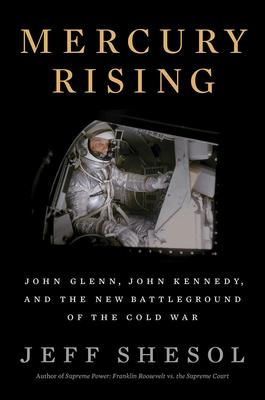On the morning of February 20th, 1962, thousands of spectators in Cape Canaveral, Florida observed the launch of Friendship 7 with John Glenn at the controls. After years of dispiriting failures, the U.S. was finally rocketing an astronaut into orbit around Earth. As the spaceship lifted off, there was palpable fear that Glenn would not survive the day. “There was a long, sorry history of these rockets horrifically exploding on the launchpad or going up and then coming down into the sea or firing their payload—some skind of scientific satellite or other—into the Atlantic,” Shesol reports.
Even Glenn anticipated failure. The astronaut wrote letters to each family member before the launch in case he did not return safely. But Friendship 7 was a success. It circled Earth three times before splashing down in the Atlantic Ocean five hours after launch.
In “Mercury Rising,” the author puts the reader behind the controls as he depicts the “white-knuckle” mission of Friendship 7 and skillfully recounts how the Cold War with Russia had heated up the space race. The book centers on Glenn, Kennedy, and world events that generated the U.S. commitment to launch an astronaut into space. The author expertly takes the reader through that amazing space odyssey, describing the cramped space capsule, Glenn's perceptions and emotions, and the reaction of the world to the historic flight.
When Cosmonaut Yuri Gagarin orbited Earth in Vostok I on April 12, 1961, space took political center stage in Washington D.C. Just one month later, President Kennedy declared that the United States would commit itself to land a man on the moon by the end of the decade.
“JFK had said during the campaign in 1960 that if the Soviets control space, they control Earth.” Both the Soviet and U.S. space programs had successes and failures, but with a free press in the U.S., failures made the world news while the Soviet failures were kept secret. This difference in reporting fed U.S. feelings of vulnerability and inflated fears that the Soviets would build a nuclear base on the moon outside the range of U.S. defenses. Then, as the Cold War heated up over the Bay of Pigs, Russia's nuclear tests, and the building of the Berlin Wall, President Kennedy voiced the conclusion that to be second in space was to be second in the critical battle between communism and freedom.
Thus, the Cold War energized the space program by helping to define its purpose and mission. The tensions between the two superpowers forced U.S. politicians and scientists to work together to commit funds and energy to implement a planetary program that would launch a series of men into space and ultimately land an American on the moon.
By the late 1960s, the Cold War competition began to fade. Several U.S successes helped ease the fear of Russian aggression and positioned the U.S. for an ongoing space program.
This year marks the centenary of John Glenn's birth, sparking the release of several books about him. He was born on July 18th, 1921, in Cambridge, Ohio, and grew up in nearby New Concord, Ohio. His first airplane ride was with his father when he was only eight. As a child, Glenn was brought up to have a sense of duty and honor to his country and he carried those traits into adulthood
After the 1941 Japanese attack on Pearl Harbor hurled the U.S. into World War II, the 20-year-old Ohioan dropped out of college and enlisted in the U.S. Army Air Corps. There he excelled in flight training and was soon assigned to the Marine Corps as a Second Lieutenant. He married his childhood sweetheart, Ann Castor, in 1943 and then was assigned to fly more than 57 combat missions around the Marshall Islands.
After the war, when the call for applicants to the space program was released, Glenn quickly applied. After a long selection process, he was chosen to be one of the first seven astronauts. Upon his retirement from NASA, John Glenn served as democratic U.S. Senator from Ohio from 1974-1999.
Shesol has written a refreshing narrative about Glenn and the space race by first examining the social and political aspects, then describing its technical challenges. By ordering the story this way, the narrative immediately draws in the reader before getting too scientific.
“Mercury Rising” is a fast and thrilling read. It will especially appeal to readers who want to learn more about the Cold War, the space race and the 1960s political climate. Shesol captures the spirit of Glenn who took the U.S. for its first orbit around Earth and then, 36 years later on a second space trip, at age 77 looked down again from space and said, “Zero-G, and I feel fine.”
About the Author: Jeff Shesol, a Rhodes scholar, is the author of “Supreme Power: Franklin Roosevelt Versus the Supreme Court” and “Mutual Contempt: Lyndon Johnson, Robert Kennedy and the Feud that Defined a Decade.” He is a former speechwriter for President Bill Clinton and a frequent contributor to the New York Times and the Washington Post. W. W. Norton and Co. is the publisher of this 400-page book which includes endnotes, a bibliography, and a thorough index.

.png)


Comments